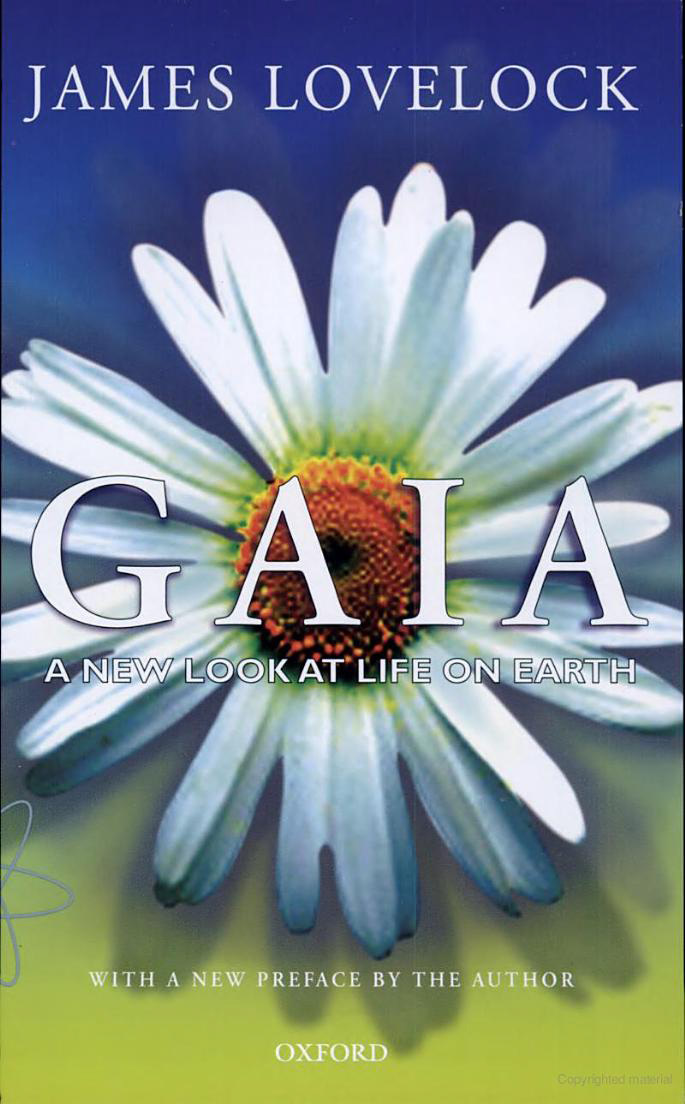 The result of this more single-minded approach was the development of the hypothesis that the entire range of living matter on Earth, from whales to viruses, and from oaks to algae, could be regarded as constituting a single living entity, capable of manipulating the Earth's atmosphere to suit its overall needs and endowed with faculties and powers far beyond those of its constituent parts. It is a long way from a plausible life-detection experiment to the hypothesis that the Earth's atmosphere is actively maintained and regulated by life on the surface, that is, by the biosphere. Much of this book deals with more recent evidence in support of this view. In 1967 the reasons for making the hypothetical stride were briefly these:
The result of this more single-minded approach was the development of the hypothesis that the entire range of living matter on Earth, from whales to viruses, and from oaks to algae, could be regarded as constituting a single living entity, capable of manipulating the Earth's atmosphere to suit its overall needs and endowed with faculties and powers far beyond those of its constituent parts. It is a long way from a plausible life-detection experiment to the hypothesis that the Earth's atmosphere is actively maintained and regulated by life on the surface, that is, by the biosphere. Much of this book deals with more recent evidence in support of this view. In 1967 the reasons for making the hypothetical stride were briefly these:
Life first appeared on the Earth about 3,500 million years ago. From that time until now, the presence of fossils shows that the Earth's climate has changed very little. Yet the output of heat from the sun, the surface properties of the Earth, and the composition of the atmosphere have almost certainly varied greatly over the same period.
The chemical composition of the atmosphere bears no relation to the expectations of steady-state chemical equilibrium. The presence of methane, nitrous oxide, and even nitrogen in our present oxidizing atmosphere represents violation of the rules of chemistry to be measured in tens of orders of magnitude. Disequilibria on this scale suggest that the atmosphere is not merely a biological product, but more probably a biological construction: not living, but like a cat's fur, a bird's feathers, or the paper of a wasp's nest, an extension of a living system designed to maintain a chosen environment. Thus the atmospheric concentration of gases such as oxygen and ammonia is found to be kept at an optimum value from which even small departures could have disastrous consequences for life.
The climate and the chemical properties of the Earth now and throughout its history seem always to have been optimal for life. For this to have happened by chance is as unlikely as to survive unscathed a drive blindfold thtough rush-hour traffic.
By now a planet-sized entity, albeit hypothetical, had been born, with properties which could not be predicted from the sum of its parts. It needed a name. Fortunately the author William Golding was a fellow-villager. Without hesitation he recommended that this creature be called Gaia, after the Greek Earth goddess also known as Ge, from which root the sciences of geography and geology derive their names. In spite of my ignorance of the classics, the suitability of this choice was obvious. It was a real four-lettered word and would thus forestall the creation of barbarous acronyms, such as Biocybernetic Universal System Tendency /Homoeostasis. I felt also that in the days of Ancient Greece the concept itself was probably a familiar aspect of life, even if not formally expressed. Scientists are usually condemned to lead urban lives, but I find that country people still living close to the earth often seem puzzled that anyone should need to make a formal proposition of anything as obvious as the Gaia hypothesis. For them it is true and always has been.
I first put forward the Gaia hypothesis at a scientific meeting about the origins of life on Earth which took place in Princeton, New Jersey, in 1968. Perhaps it was poorly presented. It certainly did not appeal to anyone except Lars Gunnar Sillen, the Scandinavian chemist now sadly dead. Lynn Margulis, of Boston University, had the task of editing our various contributions, and four years later in Boston Lynn and I met again and began a most rewarding collaboration which, with her deep knowledge and insight as a life scientist, was to go far in adding substance to the wraith of Gaia, and which still happily continues.
We have since defined Gaia as a complex entity involving the Earth's biosphere, atmosphere, oceans, and soil; the totality constituting a feedback or cybernetic system which seeks an optimal physical and chemical environment for life on this planet. The maintenance of relatively constant conditions by active control may be conveniently described by the term 'homoeostasis'.
The Gaia of this book is a hypothesis but, like other useful ypotheses, she has already proved her theoretical value, if not her existence, by giving rise to experimental questions and answers which were profitable exercises in themselves. If, for example, the atmosphere is, among other things, a device for conveying raw materials to and from the biosphere, it would be reasonable to assume the presence of carrier compounds for elements essential in all biological systems, for example, iodine and sulphur. It was re warding to find evidence that both were conveyed from the oceans, where they are abundant, through the air to the land surface, where they are in short supply. The carrier compounds, methyl iodide and dimethyl sulphide respectively, are directly produced by marine life. Scientific curiosity being unquenchable, the presence of these interesting compounds in the atmosphere would no doubt have been discovered in the end and their importance discussed without the stimulus of the Gaia hypothesis. But they were actively sought as a result of the hypothesis and their presence was consistent with it.
If Gaia exists, the relationship between her and man, a dominant animal species in the complex living system, and the possibly shifting balance of power between them, are questions of obvious importance. I have discussed them in later chapters, but this book is written primarily to stimulate and entertain. The Gaia hypothesis is for those who like to walk or simply stand and stare, to wonder about the Earth and the life it bears, and to speculate about the consequences of our own presence here. It is an alternative to that pessimistic view which sees nature as a primitive force to be subdued and conquered. It is also an alternative to that equally depressing picture of our planet as a demented spaceship, forever travelling, driverless and purpose less, around an inner circle of the sun.
from J. Lovelock, Gaia, a new look at life on earth (Oxford: Oxford University Press, 2000), pp. 9-11.


